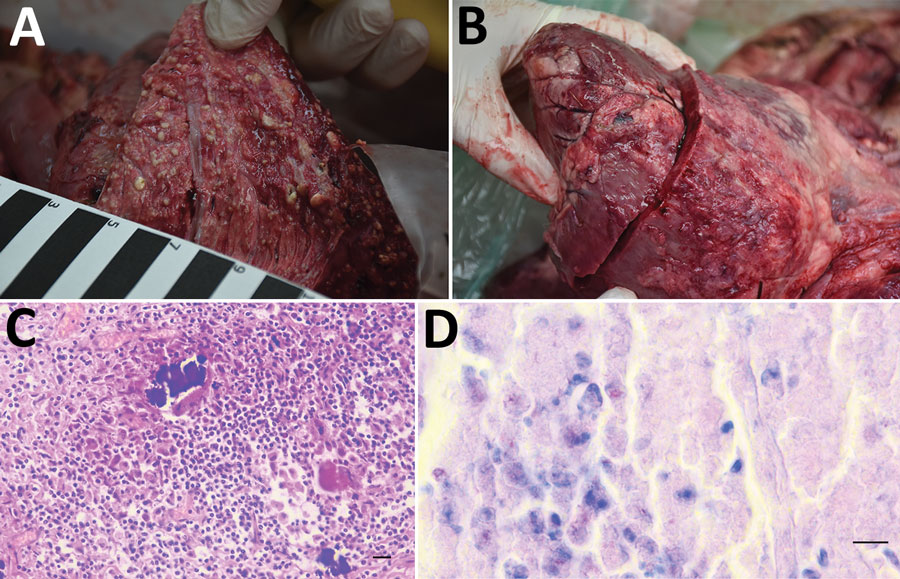Mycobacterium microti Infections in Free-Ranging Red Deer (Cervus elaphus)
Giovanni Ghielmetti

, Anne M. Kupca, Matthias Hanczaruk, Ute Friedel, Hubert Weinberger, Sandra Revilla-Fernández, Erwin Hofer, Julia M. Riehm, Roger Stephan, and Walter Glawischnig
Author affiliations: Institute for Food Safety and Hygiene, Section of Veterinary Bacteriology, Vetsuisse Faculty University of Zurich, Zurich, Switzerland (G. Ghielmetti, U. Friedel, R. Stephan); Bavarian Health and Food Safety Authority, Oberschleissheim, Germany (A.M. Kupca, M. Hanczaruk, J.M. Riehm); Institute for Veterinary Disease Control, Austrian Agency for Health and Food Safety (AGES), Innsbruck and Mödling, Austria (H. Weinberger, S. Revilla-Fernández, E. Hofer, W. Glawischnig)
Main Article
Figure 1

Figure 1. Macroscopic and histopathologic features in the red deer in case 1 in study of tuberculosis caused by Mycobacterium microti in red deer, Austria and Germany. A) Gross picture of the cutting surface of the lungs with severe pyogranulomatous pleuropneumonia with multifocal to confluent cavernous granulomas, 2–10 mm diameter. B) Multifocal to coalescing granulomas 4–25 mm diameter on the surface of the epicardium. C) Chronic multifocal to coalescing pyogranulomatous pneumonia in lungs with central areas of necrosis and mineralization surrounded by numerous epithelioid macrophages and a few multinucleated Langhans giant cells. Single lymphocytes and plasma cells were observed around the periphery and between the granulomas, hematoxylin and eosin stain. Scale bar = 20 μm. D) Numerous macrophages and epithelioid cells containing solitary or multiple acid-fast bacilli. Ziehl Neelsen stain. Scale bar = 10 μm.
Main Article
Page created: May 12, 2021
Page updated: July 18, 2021
Page reviewed: July 18, 2021
The conclusions, findings, and opinions expressed by authors contributing to this journal do not necessarily reflect the official position of the U.S. Department of Health and Human Services, the Public Health Service, the Centers for Disease Control and Prevention, or the authors' affiliated institutions. Use of trade names is for identification only and does not imply endorsement by any of the groups named above.
